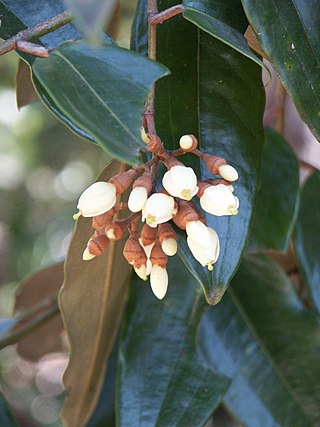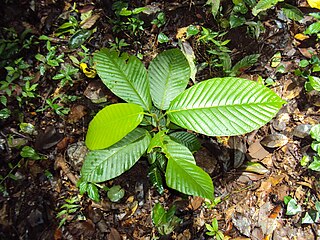
Silene is a genus of flowering plants in the family Caryophyllaceae. Containing nearly 900 species, it is the largest genus in the family. Common names include campion and catchfly. Many Silene species are widely distributed, particularly in the northern hemisphere.

The Indomalayan realm is one of the eight biogeographic realms. It extends across most of South and Southeast Asia and into the southern parts of East Asia.

The woolly monkeys are the genus Lagothrix of New World monkeys, usually placed in the family Atelidae.

Malesia is a biogeographical region straddling the Equator and the boundaries of the Indomalayan and Australasian realms, and also a phytogeographical floristic region in the Paleotropical Kingdom. The original definition by the World Geographical Scheme for Recording Plant Distributions included Papuasia, but this was split off in its 2001 version.

Dipterocarpaceae is a family of 16 genera and about 695 known species of mainly lowland tropical forest trees. Their distribution is pantropical, from northern South America to Africa, the Seychelles, India, Indochina, Indonesia, Malaysia and Philippines. The greatest diversity of Dipterocarpaceae occurs in Borneo.

Lithocarpus is a genus in the beech family, Fagaceae. Trees in this genus are commonly known as the stone oaks and differ from Quercus primarily because they produce insect-pollinated flowers on erect spikes and the female flowers have short styles with punctate stigmas. At current, around 340 species have been described, mostly restricted to Southeast Asia. Fossils show that Lithocarpus formerly had a wider distribution, being found in North America and Europe during the Eocene to Miocene epochs. The species extend from the foothills of the Hengduan Mountains, where they form dominant stands of trees, through Indochina and the Malayan Archipelago, crossing Wallace's Line and reaching Papua. In general, these trees are most dominant in the uplands and have many ecological similarities to the Dipterocarpaceae, the dominant lowland tree group. These trees are intolerant of seasonal droughts, not being found on the Lesser Sunda Islands, despite their ability to cross numerous water barriers to reach Papua.

The Sarcolaenaceae are a family of flowering plants endemic to Madagascar. The family includes 79 species of mostly evergreen trees and shrubs in ten genera.

Shorea is a genus of about 196 species of mainly rainforest trees in the family Dipterocarpaceae. The genus is named after Sir John Shore, the governor-general of the British East India Company, 1793–1798. The timber of trees of the genus is sold under the common names lauan, luan, lawaan, meranti, seraya, balau, bangkirai, and Philippine mahogany.
Philippine mahogany is a common name for several different species of trees and their wood.

Dipterocarpus is a genus of flowering plants and the type genus of family Dipterocarpaceae.

Dr. André Joseph Guillaume Henri 'Dok' Kostermans was an Indonesian botanist of Dutch ancestry. He was born in Purworejo, Java, Dutch East Indies, and educated at Utrecht University, taking his doctoral degree in 1936 with a paper on Surinamese Lauraceae.

Choreutidae, or metalmark moths, are a family of insects in the lepidopteran order whose relationships have been long disputed. It was placed previously in the superfamily Yponomeutoidea in family Glyphipterigidae and in superfamily Sesioidea. It is now considered to represent its own superfamily. The relationship of the family to the other lineages in the group "Apoditrysia" need a new assessment, especially with new molecular data.

Stemonoporus is a genus of plants in the family Dipterocarpaceae. The genus is endemic to Sri Lanka. It contains as many as 26 species, all but one confined to the perhumid forests of the island.

Anisoptera is a genus of plants in the family Dipterocarpaceae. It contains ten species distributed from Chittagong in southeast of Bangladesh to New Guinea.

Beesoniidae is a family of scale insects commonly known as beesoniids. They typically cause galls on their plant hosts. Members of this family mostly come from southern Asia. The family name comes from the type genus Beesonia which is named after the entomologist C.F.C. Beeson who obtained the specimens from which they were described and named.

Monotoideae is a subfamily of the plant family Dipterocarpaceae, with 3 genera and 30 species. It is native to the rainforest habitat of Africa and Madagascar, as well as South America. The geographical discontinuity can be traced back to a date prior to the separation of these land masses and the subsequent migration, evolution and preservation of the species in suitable habitats.
Pakaraimaea is a genus of trees in the family Cistaceae. The genus contains a single species, Pakaraimaea dipterocarpacea, from South America. It was formerly placed in subfamily Pakaraimoideae of the family Dipterocarpaceae. The species is found in the western highlands of Guyana and in adjacent Bolivar State in Venezuela. It maintains strong ectomycorrhizal associations with a wide variety of fungal species. The trees can sometimes be seen forming large stands in the western Guyanas.

Dipterocarpus intricatus is a species of tree in the family Dipterocarpaceae found in Thailand, Cambodia, Laos and Vietnam.















